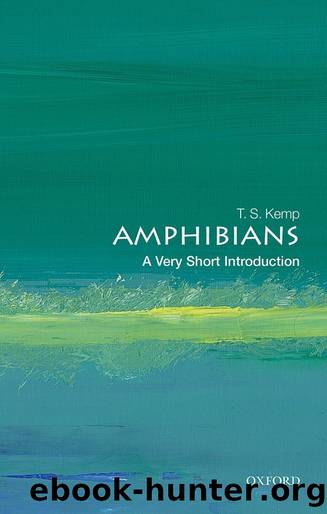Amphibians by T. S. Kemp

Author:T. S. Kemp [Kemp, T. S.]
Language: eng
Format: epub
ISBN: 9780192580856
Publisher: OUP Oxford
Published: 2021-04-09T00:00:00+00:00
Most amphibians simply abandon their fertilized eggs in a suitable pond, lake, or slow-flowing stream and pay no more attention to them. These unprotected eggs, and the larvae which hatch from them, are vulnerable to a range of hazards. Predators include voracious insects, leeches, fish, and snakes, not to mention other amphibians, including cannibalism by adults of the same species. Bacterial and fungal pathogens are ever-present dangers, as is desiccation in many warmer parts of the world, while fast-flowing water risks them being swept away downstream. However, getting on for 20 per cent of amphibians have reduced these risks by evolving an impressive range of parental care. It may be no more complicated than the parents laying the eggs in a safer place than open water, where they would be at immediate risk of predation. Some species go further, and one or both parents remain in attendance to protect the eggs. Another method is to lay the eggs and fertilize them on land in a suitably damp place, and then actively carry the newly hatched tadpoles to water where they can feed and complete their development. Several of the most extraordinary examples consist of one or other of the parents keeping the fertilized eggs on or in part of the body, and sometimes this also includes the tadpoles.
The red-eyed tree frog of Costa Rica is the most strikingly colourful of anurans, with its red eyes, brilliant green body, blue and yellow side stripes, and orange feet. During amplexus, the eggs are laid and fertilized on the surface of a leaf directly above a pond. They are covered in a layer of mucous, which makes them stick and helps prevent them drying out. The eggs hatch after about a week, although it can occur earlier in response to the presence of a predator such as a snake. The tadpoles drop down into the water below, where they proceed to follow a normal tadpole life. Another example is the Taiwanese temple tree frog, which lays its eggs under dead leaves near to the edge of a stream. When ready, heavy rainfall stimulates them to hatch and washes the emerging tadpoles into the water.
The grey foam-nest tree frog, which inhabits seasonally dry areas of southern Africa, has a more complicated way of using overhanging foliage. After it has rained, the female, with a male in tow, finds a suitable branch above a pool of water and covers it with a thin, mucous fluid. She lays her eggs in this, and is then joined by as many as twenty other males, who all produce sperm to fertilize the eggs, and then energetically kick the mixture into a bubbly mass of foam. The eggs develop within the nest and hatch into tadpoles that once again drop down into the water directly below.
Protection of the eggs may be provided by the parents constructing a nest floating on the surface of the water. An example of this is the little, 30 mm long túngara frog (Figure 16a) that lives in dry forests of Central and tropical South America.
Download
This site does not store any files on its server. We only index and link to content provided by other sites. Please contact the content providers to delete copyright contents if any and email us, we'll remove relevant links or contents immediately.
Essentials of Geology by Stephen Marshak(389)
Spectral Geometry and Inverse Scattering Theory by Huaian Diao & Hongyu Liu(280)
Probably Overthinking It: How to Use Data to Answer Questions, Avoid Statistical Traps, and Make Better Decisions by Allen B. Downey(269)
The Readable Darwin by Pechenik Jan A.;(263)
Hydrocarbon transformations in sediments from the Cathedral Hill hydrothermal vent complex at Guaymas Basin, Gulf of California ââ¬â A chemometric study of shallow seep architecture by unknow(262)
How to succeed in EPSO numerical reasoning tests by Franco Reverte José María(239)
Great Ways to Learn Anatomy and Physiology by McKissock Charmaine;(232)
Quantum International Relations by James Der Derian(231)
Research and Publication Ethics by Santosh Kumar Yadav(231)
Mathematical Models in Economics. Lections by Shananin(230)
Weathering: Types, Processes and Effects: Types, Processes and Effects by Matthew J. J. Colon(226)
Dark Matter in the Universe by John N. Bahcall(223)
Fusion of Defects by Arthur Bartels; Christopher Douglas; André Henriques(214)
Cosmic Rays by Alessandro De Angelis(211)
Sampling by Lohr Sharon L.;(205)
Mathematics Booster-1 by Singh Manoj Kumar(205)
The Structure of Scientific Inference by Mary B. Hesse(204)
Pearls from a Lost City: The LVOV School of Mathematics (History of Mathematics) (History of Mathematics, 40) by Roman Duda(199)
Flora Unveiled by Taiz Lincoln;Taiz Lee;(190)
